Study on Bottom Distributed Bragg Reflector Radius and Electric Aperture Radius on Performance Characteristics of GaN-Based Vertical-Cavity Surface-Emitting Laser
Abstract
1. Introduction
2. Materials and Methods
2.1. Structure
2.2. Numerical Model
3. Results and Discussion
4. Conclusions
Author Contributions
Funding
Institutional Review Board Statement
Informed Consent Statement
Data Availability Statement
Acknowledgments
Conflicts of Interest
References
- Cartwright, H.; Turner, A.F. Minutes of the Washington, DC, Meeting, 27–29 April 1939. Phys. Rev. 1939, 55, 1109–1147. [Google Scholar]
- Dimmick, G. A New Dichroic Reflector and Its Application to Protocell Monitoring Systems. J. Soc. Motion Pict. Eng. 1942, 38, 36–44. [Google Scholar] [CrossRef]
- Banning, M. Practical Methods of Making and Using Multilayer Filters. JOSA 1947, 37, 792–797. [Google Scholar] [CrossRef] [PubMed]
- Maruska, H.P.; Rhines, W.C. A Modern Perspective on the History of Semiconductor Nitride Blue Light Sources. Solid State Electron 2015, 111, 32–41. [Google Scholar] [CrossRef]
- Hamaguchi, T.; Tanaka, M.; Nakajima, H. A Review on the Latest Progress of Visible GaN-Based VCSELs with Lateral Confinement by Curved Dielectric DBR Reflector and Boron Ion Implantation. Jpn. J. Appl. Phys. 2019, 58, SC0806. [Google Scholar] [CrossRef]
- Yu, H.; Zheng, Z.; Mei, Y.; Xu, R.; Liu, J.; Yang, H.; Zhang, B.; Lu, T.; Kuo, H. Progress and Prospects of GaN-Based VCSEL from near UV to Green Emission. Prog. Quantum Electron 2018, 57, 1–19. [Google Scholar] [CrossRef]
- Haglund, Å.; Hashemi, E.; Bengtsson, J.; Gustavsson, J.; Stattin, M.; Calciati, M.; Goano, M. Progress and Challenges in Electrically Pumped GaN-Based VCSELs. In Proceedings of the Semiconductor Lasers and Laser Dynamics VII; Panajotov, K., Sciamanna, M., Valle, A., Michalzik, R., Eds.; SPIE: Bellingham, WA, USA, 2016; Volume 9892, p. 98920Y. [Google Scholar]
- Hayashi, K.; Hamaguchi, T.; Kearns, J.A.; Kobayashi, N.; Ohara, M.; Makino, T.; Nagane, S.; Sato, K.; Nakamura, Y.; Hoshina, Y.; et al. Narrow Emission of Blue GaN-Based Vertical-Cavity Surface-Emitting Lasers With a Curved Mirror. IEEE Photonics J. 2022, 14, 1536905. [Google Scholar] [CrossRef]
- Nakajima, H.; Hamaguchi, T.; Tanaka, M.; Ito, M.; Jyokawa, T.; Matou, T.; Hayashi, K.; Ohara, M.; Kobayashi, N.; Watanabe, H.; et al. Single Transverse Mode Operation of GaN-Based Vertical-Cavity Surface-Emitting Laser with Monolithically Incorporated Curved Mirror. Appl. Phys. Express 2019, 12, 084003. [Google Scholar] [CrossRef]
- Kuramoto, M.; Kobayashi, S.; Akagi, T.; Tazawa, K.; Tanaka, K.; Nakata, K.; Saito, T. Watt-Class Blue Vertical-Cavity Surface-Emitting Laser Arrays. Appl. Phys. Express 2019, 12, 91004. [Google Scholar] [CrossRef]
- Terao, K.; Nagai, H.; Morita, D.; Masui, S.; Yanamoto, T.; Nagahama, S. Blue and Green GaN-Based Vertical-Cavity Surface-Emitting Lasers with AlInN/GaN DBR. In Proceedings of the SPIE, San Francisco, CA, USA, 5 March 2021; Volume 11686, p. 116860E. [Google Scholar]
- Kuramoto, M.; Kobayashi, S.; Akagi, T.; Tazawa, K.; Tanaka, K.; Saito, T.; Takeuchi, T. High-Output-Power and High-Temperature Operation of Blue GaN-Based Vertical-Cavity Surface-Emitting Laser. Appl. Phys. Express 2018, 11, 112101. [Google Scholar] [CrossRef]
- Gasonoo, A.; Ahn, H.-S.; Lim, S.; Lee, J.-H.; Choi, Y. Color Glass by Layered Nitride Films for Building Integrated Photovoltaic (BIPV) System. Crystals 2021, 11, 281. [Google Scholar] [CrossRef]
- Liu, Y.; Ghafari, E.; Jiang, X.; Feng, Y.; Feng, Z.; Ferguson, I.; Lu, N. Temperature-Dependent Optical Properties of AlN Thin Films by Spectroscopy Ellipsometry. MRS Adv. 2017, 2, 323–328. [Google Scholar] [CrossRef]
- Ni, X.; Shimada, R.; Kang, T.D.; Leach, J.; Özgür, Ü.; Morkoç, H. GaN-Based Vertical Cavities on Highly Reflective and Crack-Free Nitride Distributed Bragg Reflectors. In Proceedings of the SPIE, San Jose, CA, USA, 19 February 2009; Volume 7216, p. 72162F. [Google Scholar]
- Carlin, J.-F.; Zellweger, C.; Dorsaz, J.; Nicolay, S.; Christmann, G.; Feltin, E.; Butté, R.; Grandjean, N. Progresses in III-Nitride Distributed Bragg Reflectors and Microcavities Using AlInN/GaN Materials. Phys. Status Solidi (b) 2005, 242, 2326–2344. [Google Scholar] [CrossRef]
- Kao, C.-C.; Peng, Y.C.; Yao, H.H.; Tsai, J.Y.; Chang, Y.H.; Chu, J.T.; Huang, H.W.; Kao, T.T.; Lu, T.C.; Kuo, H.C.; et al. Fabrication and Performance of Blue GaN-Based Vertical-Cavity Surface Emitting Laser Employing AlN/GaN and Ta2O5/SiO2 Distributed Bragg Reflector. Appl. Phys. Lett. 2005, 87, 081105. [Google Scholar] [CrossRef]
- Zhang, J.; Tong, H.; Liu, G.; Herbsommer, J.A.; Huang, G.S.; Tansu, N. Thermoelectric Properties of MOCVD-Grown AlInN Alloys with Various Compositions. In Proceedings of the SPIE, Orlando, FL, USA, 3 March 2011; Volume 7939, p. 79390O. [Google Scholar]
- Hayashi, N.; Ogimoto, J.; Matsui, K.; Furuta, T.; Akagi, T.; Iwayama, S.; Takeuchi, T.; Kamiyama, S.; Iwaya, M.; Akasaki, I. A GaN-Based VCSEL with a Convex Structure for Optical Guiding. Phys. Status Solidi (a) 2018, 215, 1700648. [Google Scholar] [CrossRef]
- Lu, T.-C.; Kao, C.-C.; Kuo, H.-C.; Huang, G.-S.; Wang, S.-C. CW Lasing of Current Injection Blue GaN-Based Vertical Cavity Surface Emitting Laser. Appl. Phys. Lett. 2008, 92, 141102. [Google Scholar] [CrossRef]
- Kuramoto, M.; Kobayashi, S.; Akagi, T.; Tazawa, K.; Tanaka, K.; Saito, T.; Takeuchi, T. Enhancement of Slope Efficiency and Output Power in GaN-Based Vertical-Cavity Surface-Emitting Lasers with a SiO2-Buried Lateral Index Guide. Appl. Phys. Lett. 2018, 112, 111104. [Google Scholar] [CrossRef]
- Kuramoto, M.; Kobayashi, S.; Akagi, T.; Tazawa, K.; Tanaka, H.; Takeuchi, T. Nano-Height Cylindrical Waveguide in GaN-Based Vertical-Cavity Surface-Emitting Lasers. Appl. Phys. Express 2020, 13, 082005. [Google Scholar] [CrossRef]
- Huang, C.-Y.; Hong, K.-B.; Huang, Z.-T.; Hsieh, W.-H.; Huang, W.-H.; Lu, T. Challenges and Advancement of Blue III-Nitride Vertical-Cavity Surface-Emitting Lasers. Micromachines 2021, 12, 676. [Google Scholar] [CrossRef]
- Kogelnik, H.; Li, T. Laser Beams and Resonators. Appl. Opt. 1966, 5, 1550–1567. [Google Scholar] [CrossRef]
- Park, S.-H.; Kim, J.; Jeon, H.; Sakong, T.; Lee, S.-N.; Chae, S.; Park, Y.; Jeong, C.-H.; Yeom, G.-Y.; Cho, Y.-H. Room-Temperature GaN Vertical-Cavity Surface-Emitting Laser Operation in an Extended Cavity Scheme. Appl. Phys. Lett. 2003, 83, 2121–2123. [Google Scholar] [CrossRef]
- Hamaguchi, T.; Tanaka, M.; Mitomo, J.; Nakajima, H.; Ito, M.; Ohara, M.; Kobayashi, N.; Fujii, K.; Watanabe, H.; Satou, S.; et al. Lateral Optical Confinement of GaN-Based VCSEL Using an Atomically Smooth Monolithic Curved Mirror. Sci. Rep. 2018, 8, 10350. [Google Scholar] [CrossRef] [PubMed]
- Hamaguchi, T.; Nakajima, H.; Ito, M.; Mitomo, J.; Satou, S.; Fuutagawa, N.; Narui, H. Lateral Carrier Confinement of GaN-Based Vertical-Cavity Surface-Emitting Diodes Using Boron Ion Implantation. Jpn. J. Appl. Phys. 2016, 55, 122101. [Google Scholar] [CrossRef]
- Hamaguchi, T.; Nakajima, H.; Tanaka, M.; Ito, M.; Ohara, M.; Jyoukawa, T.; Kobayashi, N.; Matou, T.; Hayashi, K.; Watanabe, H.; et al. Sub-Milliampere-Threshold Continuous Wave Operation of GaN-Based Vertical-Cavity Surface-Emitting Laser with Lateral Optical Confinement by Curved Mirror. Appl. Phys. Express 2019, 12, 44004. [Google Scholar] [CrossRef]
- Ito, M.; Hamaguchi, T.; Makino, T.; Hayashi, K.; Kearns, J.A.; Ohara, M.; Kobayashi, N.; Nagane, S.; Sato, K.; Nakamura, Y.; et al. Highly Efficient Operation and Uniform Characteristics of Curved Mirror Vertical-Cavity Surface-Emitting Lasers. Appl. Phys. Express 2023, 16, 12006. [Google Scholar] [CrossRef]
- Kearns, J.A.; Hamaguchi, T.; Hayashi, K.; Ohara, M.; Makino, T.; Ito, M.; Kobayashi, N.; Jyokawa, T.; Nakayama, E.; Nagane, S.; et al. Mode Control in Long Cavity VCSELs with a Curved Mirror. In Proceedings of the SPIE, Big Sky, MT, USA, 5 March 2022; Volume 12001, p. 1200108. [Google Scholar]
- Hamaguchi, T.; Makino, T.; Hayashi, K.; Kearns, J.A.; Ohara, M.; Ito, M.; Kobayashi, N.; Nagane, S.; Sato, K.; Nakamura, Y.; et al. Spontaneously Implemented Spatial Coherence in Vertical-Cavity Surface-Emitting Laser Dot Array. Sci. Rep. 2022, 12, 21629. [Google Scholar] [CrossRef] [PubMed]
- Hamaguchi, T.; Hoshina, Y.; Hayashi, K.; Tanaka, M.; Ito, M.; Ohara, M.; Jyoukawa, T.; Kobayashi, N.; Watanabe, H.; Yokozeki, M.; et al. Room-Temperature Continuous-Wave Operation of Green Vertical-Cavity Surface-Emitting Lasers with a Curved Mirror Fabricated on 20−21 Semi-Polar GaN. Appl. Phys. Express 2020, 13, 41002. [Google Scholar] [CrossRef]
- Ito, M.; Hamaguchi, T.; Makino, T.; Hayashi, K.; Kearns, J.A.; Ohara, M.; Kobayashi, N.; Nagane, S.; Sato, K.; Nakamura, Y.; et al. Latest Progress of High-Efficient Blue and Green VCSELs with Curved Mirror. Proc. Int. Disp. Workshops 2022, 2022, 742. [Google Scholar] [CrossRef]
- Chang-Hasnain, C.; Zhou, Y.; Huang, M.; Chase, C. High-Contrast Grating VCSELs. Selected Topics in Quantum Electronics. IEEE J. 2009, 15, 869–878. [Google Scholar] [CrossRef]
- Chang-Hasnain, C.J.; Yang, W. High-Contrast Gratings for Integrated Optoelectronics. Adv. Opt. Photon. 2012, 4, 379–440. [Google Scholar] [CrossRef]
- Kim, S.; Wang, Z.; Brodbeck, S.; Schneider, C.; Höfling, S.; Deng, H. Monolithic High-Contrast Grating Based Polariton Laser. ACS Photonics 2019, 6, 18–22. [Google Scholar] [CrossRef]
- Gębski, M.; Lott, J.A.; Czyszanowski, T. Electrically Injected VCSEL with a Composite DBR and MHCG Reflector. Opt. Express 2019, 27, 7139–7146. [Google Scholar] [CrossRef] [PubMed]
- Chang, T.-C.; Hong, K.-B.; Kuo, S.-Y.; Lu, T.-C. Demonstration of Polarization Control GaN-Based Micro-Cavity Lasers Using a Rigid High-Contrast Grating Reflector. Sci. Rep. 2019, 9, 13055. [Google Scholar] [CrossRef]
- Chang, T.-C.; Hashemi, E.; Hong, K.-B.; Bengtsson, J.; Gustavsson, J.; Haglund, Å.; Lu, T.-C. Electrically Injected GaN-Based Vertical-Cavity Surface-Emitting Lasers with TiO2 High-Index-Contrast Grating Reflectors. ACS Photonics 2020, 7, 861–866. [Google Scholar] [CrossRef]
- Hong, K.-B.; Chang, T.-C.; Hjort, F.; Lindvall, N.; Hsieh, W.-H.; Huang, W.-H.; Tsai, P.-H.; Czyszanowski, T.; Haglund, Å.; Lu, T.-C. Monolithic High-Index Contrast Grating Mirror for a GaN-Based Vertical-Cavity Surface-Emitting Laser. Photon. Res. 2021, 9, 2214–2221. [Google Scholar] [CrossRef]
- Leonard, J.T.; Young, E.C.; Yonkee, B.P.; Cohen, D.A.; Shen, C.; Margalith, T.; Ng, T.K.; DenBaars, S.P.; Ooi, B.S.; Speck, J.S.; et al. Comparison of Nonpolar III-Nitride Vertical-Cavity Surface-Emitting Lasers with Tunnel Junction and ITO Intracavity Contacts. In Proceedings of the Gallium Nitride Materials and Devices XI; Chyi, J.-I., Fujioka, H., Morkoç, H., Nanishi, Y., Schwarz, U.T., Shim, J.-I., Eds.; SPIE: Bellingham, WA, USA, 2016; Volume 9748, p. 97481B. [Google Scholar]
- Wang, H.; Kawahito, Y.; Yoshida, R.; Nakashima, Y.; Shiokawa, K. Development of a High-Power Blue Laser (445 nm) for Material Processing. Opt. Lett. 2017, 42, 2251–2254. [Google Scholar] [CrossRef]
- Nakatsu, Y.; Nagao, Y.; Kozuru, K.; Hirao, T.; Okahisa, E.; Masui, S.; Yanamoto, T.; Nagahama, S. High-Efficiency Blue and Green Laser Diodes for Laser Displays. In Proceedings of the SPIE, San Francisco, CA, USA, 1 March 2019; Volume 10918, p. 109181D. [Google Scholar]
- Xiu, H.; Xu, P.; Wen, P.; Zhang, Y.; Yang, J. Rapid Degradation of InGaN/GaN Green Laser Diodes. Superlattices Microstruct 2020, 142, 106517. [Google Scholar] [CrossRef]
- Marioli, M.; Meneghini, M.; Rossi, F.; Salviati, G.; de Santi, C.; Mura, G.; Meneghesso, G.; Zanoni, E. Degradation Mechanisms and Lifetime of State-of-the-Art Green Laser Diodes. Phys. Status Solidi (a) 2015, 212, 974–979. [Google Scholar] [CrossRef]
- Tian, A.; Hu, L.; Zhang, L.; Liu, J.; Yang, H. Design and Growth of GaN-Based Blue and Green Laser Diodes. Sci. China Mater 2020, 63, 1348–1363. [Google Scholar] [CrossRef]
- Lide, D.R. CRC Handbook of Chemistry and Physics; CRC Press: Boca Raton, FL, USA, 2004; Volume 85. [Google Scholar]
- Shackelford, J.F.; Alexander, W. (Eds.) CRC Materials Science and Engineering Handbook; CRC Press: Boca Raton, FL, USA, 2000; ISBN 9780429117862. [Google Scholar]
- Farsi, A.; Siciliani de Cumis, M.; Marino, F.; Marin, F. Photothermal and Thermo-Refractive Effects in High Reflectivity Mirrors at Room and Cryogenic Temperature. J. Appl. Phys. 2012, 111, 043101. [Google Scholar] [CrossRef]
- Kuc, M.; Sarzała, R.P.; Nakwaski, W. Thermal Crosstalk in Arrays of III-N-Based Lasers. Mater. Sci. Eng. B 2013, 178, 1395–1402. [Google Scholar] [CrossRef]
- Strauβ, U.; Hager, T.; Brüderl, G.; Wurm, T.; Somers, A.; Eichler, C.; Vierheilig, C.; Löffler, A.; Ristic, J.; Avramescu, A. Recent Advances in C-Plane GaN Visible Lasers. In Proceedings of the Gallium Nitride Materials and Devices IX; Chyi, J.-I., Nanishi, Y., Morkoç, H., Piprek, J., Yoon, E., Fujioka, H., Eds.; SPIE: Bellingham, WA, USA, 2014; Volume 8986, p. 89861L. [Google Scholar]
- Scheibenzuber, W.G.; Schwarz, U.T.; Sulmoni, L.; Dorsaz, J.; Carlin, J.-F.; Grandjean, N. Recombination Coefficients of GaN-Based Laser Diodes. J. Appl. Phys. 2011, 109, 093106. [Google Scholar] [CrossRef]
- Shen, Y.C.; Mueller, G.O.; Watanabe, S.; Gardner, N.F.; Munkholm, A.; Krames, M.R. Auger Recombination in InGaN Measured by Photoluminescence. Appl. Phys. Lett. 2007, 91, 141101. [Google Scholar] [CrossRef]
- David, A.; Grundmann, M.J. Droop in InGaN Light-Emitting Diodes: A Differential Carrier Lifetime Analysis. Appl. Phys. Lett. 2010, 96, 103504. [Google Scholar] [CrossRef]
- Meyaard, D.S.; Shan, Q.; Dai, Q.; Cho, J.; Schubert, E.F.; Kim, M.-H.; Sone, C. On the Temperature Dependence of Electron Leakage from the Active Region of GaInN/GaN Light-Emitting Diodes. Appl. Phys. Lett. 2011, 99, 041112. [Google Scholar] [CrossRef]
- Fu, H.; Lu, Z.; Zhao, Y. Analysis of Low Efficiency droop of Semipolar InGaN Quantum Well Light-Emitting Diodes by Modified Rate Equation with Weak Phase-Space Filling Effect. AIP Adv. 2016, 6, 065013. [Google Scholar] [CrossRef]
- Kuc, M.; Sokół, A.K.; Piskorski, Ł.; Dems, M.; Wasiak, M.; Sarzała, R.P.; Czyszanowski, T. ITO Layer as an Optical Confinement for Nitride Edge-Emitting Lasers. Bull. Pol. Acad. Sci. Tech. Sci. 2020, 68, 147–154. [Google Scholar] [CrossRef]
- Dmitriev, A.; Oruzheinikov, A. The Rate of Radiative Recombination in the Nitride Semiconductors and Alloys. J. Appl. Phys. 1999, 86, 3241–3246. [Google Scholar] [CrossRef]
- Piprek, J.; Römer, F.; Witzigmann, B. On the Uncertainty of the Auger Recombination Coefficient Extracted from InGaN/GaN Light-Emitting Diode Efficiency Droop Measurements. Appl. Phys. Lett. 2015, 106, 101101. [Google Scholar] [CrossRef]
- Hader, J.; Moloney, J.V.; Pasenow, B.; Koch, S.W.; Sabathil, M.; Linder, N.; Lutgen, S. On the Importance of Radiative and Auger Losses in GaN-Based Quantum Wells. Appl. Phys. Lett. 2008, 92, 261103. [Google Scholar] [CrossRef]
- Zhang, M.; Bhattacharya, P.; Singh, J.; Hinckley, J. Direct Measurement of Auger Recombination in In0.1Ga0.9N/GaN Quantum Wells and Its Impact on the Efficiency of In0.1Ga0.9 N/GaN Multiple Quantum Well Light Emitting Diodes. Appl. Phys. Lett. 2009, 95, 201108. [Google Scholar] [CrossRef]
- Ščajev, P.; Jarašiūnas, K.; Okur, S.; Özgür, Ü.; Morkoç, H. Carrier Dynamics in Bulk GaN. J. Appl. Phys. 2012, 111, 023702. [Google Scholar] [CrossRef]
- Konoplev, S.S.; Bulashevich, K.A.; Karpov, S.Y. From Large-Size to Micro-LEDs: Scaling Trends Revealed by Modeling. Phys. Status Solidi (a) 2018, 215, 1700508. [Google Scholar] [CrossRef]
- Mensi, M.; Ivanov, R.; Uždavinys, T.K.; Kelchner, K.M.; Nakamura, S.; DenBaars, S.P.; Speck, J.S.; Marcinkevičius, S. Direct Measurement of Nanoscale Lateral Carrier Diffusion: Toward Scanning Diffusion Microscopy. ACS Photonics 2018, 5, 528–534. [Google Scholar] [CrossRef]
- Aleksiejūnas, R.; Sūdžius, M.; Gudelis, V.; Malinauskas, T.; Jarašiūnas, K.; Fareed, Q.; Gaska, R.; Shur, M.S.; Zhang, J.; Yang, J.; et al. Carrier Transport and Recombination in InGaN/GaN Heterostructures, Studied by Optical Four-Wave Mixing Technique. Phys. Status Solidi (c) 2003, 2686–2690. [Google Scholar] [CrossRef]
- Chuang, S.L. Physics of Optoelectronic Devices; Wiley & Sons, Incorporated, John: Hoboken, NJ, USA, 1995. [Google Scholar]
- Wenzel, H.; Wunsche, H.-J. The Effective Frequency Method in the Analysis of Vertical-Cavity Surface-Emitting Lasers. IEEE J. Quantum Electron 1997, 33, 1156–1162. [Google Scholar] [CrossRef]
- McPeak, K.M.; Jayanti, S.V.; Kress, S.J.P.; Meyer, S.; Iotti, S.; Rossinelli, A.; Norris, D.J. Plasmonic Films Can Easily Be Better: Rules and Recipes. ACS Photonics 2015, 2, 326–333. [Google Scholar] [CrossRef] [PubMed]
- Olmon, R.L.; Slovick, B.; Johnson, T.W.; Shelton, D.; Oh, S.-H.; Boreman, G.D.; Raschke, M.B. Optical Dielectric Function of Gold. Phys. Rev. B 2012, 86, 235147. [Google Scholar] [CrossRef]
- Gao, L.; Lemarchand, F.; Lequime, M. Refractive Index Determination of SiO2 Layer in the UV/Vis/NIR Range: Spectrophotometric Reverse Engineering on Single and Bi-Layer Designs. J. Eur. Opt. Soc. Rapid. Publ. 2013, 8, 13010. [Google Scholar] [CrossRef]
- Gao, L.; Lemarchand, F.; Lequime, M. Exploitation of Multiple Incidences Spectrometric Measurements for Thin Film Reverse Engineering. Opt. Express 2012, 20, 15734–15751. [Google Scholar] [CrossRef]
- Hajdel, M.; Muziol, G.; Nowakowski-Szkudlarek, K.; Siekacz, M.; Feduniewicz-Żmuda, A.; Wolny, P.; Skierbiszewski, C. Influence of Electron Blocking Layer on Properties of InGaN-Based Laser Diodes Grown by Plasma-Assisted Molecular Beam Epitaxy. Acta Phys. Pol. A 2019, 136, 593–597. [Google Scholar] [CrossRef]
- Zhao, H.; Liu, G.; Arif, R.A.; Tansu, N. Current Injection Efficiency Induced Efficiency-Droop in InGaN Quantum Well Light-Emitting Diodes. Solid State Electron 2010, 54, 1119–1124. [Google Scholar] [CrossRef]
- David, A.; Young, N.G.; Lund, C.; Craven, M.D. Review—The Physics of Recombinations in III-Nitride Emitters. ECS J. Solid State Sci. Technol. 2020, 9, 016021. [Google Scholar] [CrossRef]
- Hurni, C.A.; David, A.; Cich, M.J.; Aldaz, R.I.; Ellis, B.; Huang, K.; Tyagi, A.; DeLille, R.A.; Craven, M.D.; Steranka, F.M.; et al. Bulk GaN Flip-Chip Violet Light-Emitting Diodes with Optimized Efficiency for High-Power Operation. Appl. Phys. Lett. 2015, 106, 031101. [Google Scholar] [CrossRef]
- Sarzała, R.P. Computer Simulation of Performance Characteristics of (GaIn)(NAs) Diode Lasers. Opt. Appl. 2002, 32, 449–460. [Google Scholar]
- Sarzala, R.P. Modeling of the Threshold Operation of 1.3-µm GaAs-Based Oxide-Confined (InGa)As-GaAs Quantum-Dot Vertical-Cavity Surface-Emitting Lasers. IEEE J. Quantum Electron 2004, 40, 629–639. [Google Scholar] [CrossRef]
- Sarzała, R.P. Designing Strategy to Enhance Mode Selectivity of Higher-Output Oxide-Confined Vertical-Cavity Surface-Emitting Lasers. Appl. Phys. A 2005, 81, 275–283. [Google Scholar] [CrossRef]
- Sarzała, R.P.; Mendla, P.; Wasiak, M.; Maćkowiak, P.; Bugajski, M.; Nakwaski, W. Comprehensive Self-Consistent Three-Dimensional Simulation of an Operation of the GaAs-Based Oxide-Confined 1.3-Μm Quantum-Dot (InGa)As/GaAs Vertical-Cavity Surface-Emitting Lasers. Opt. Quantum Electron 2004, 36, 331–347. [Google Scholar] [CrossRef]
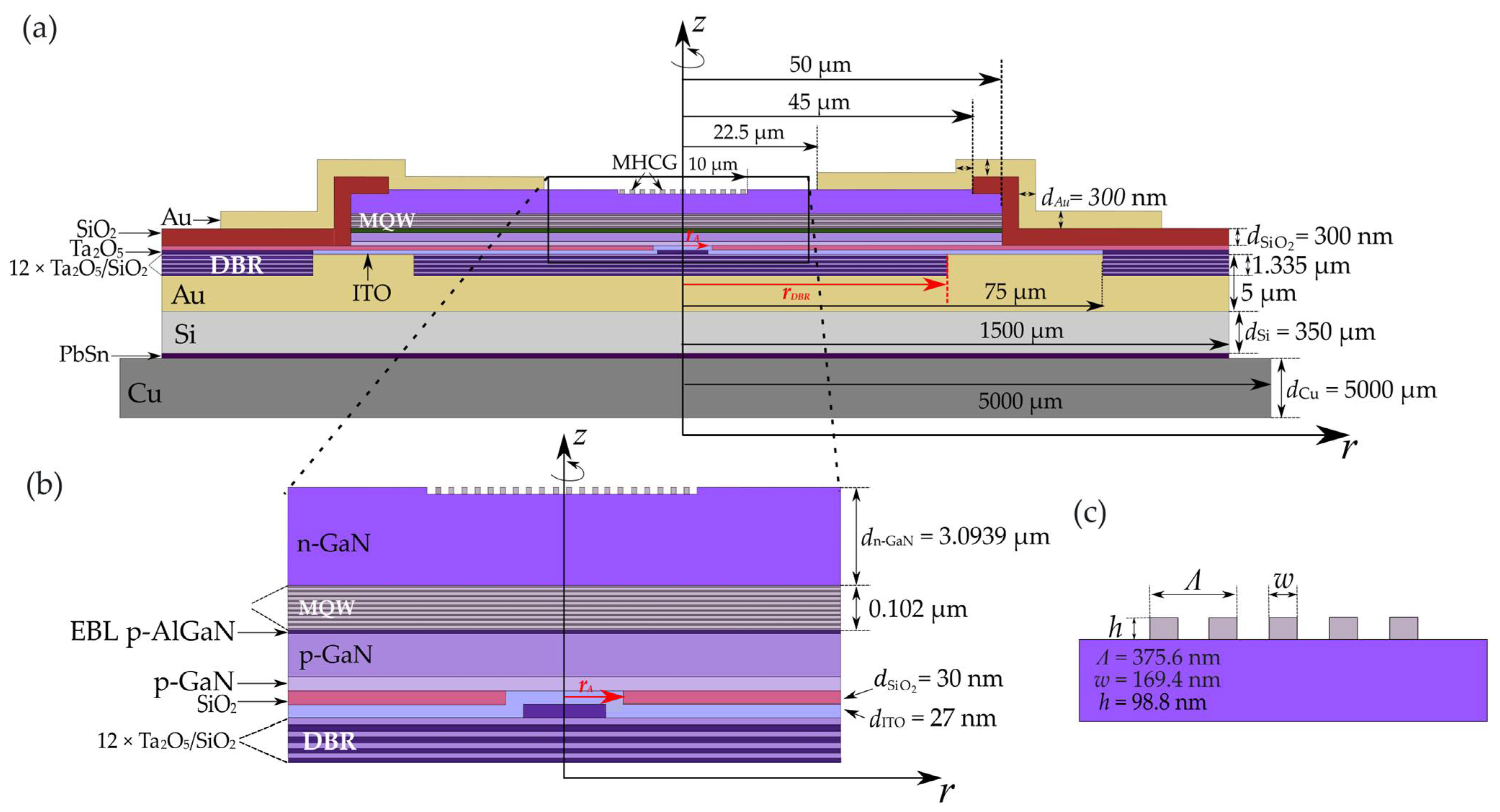
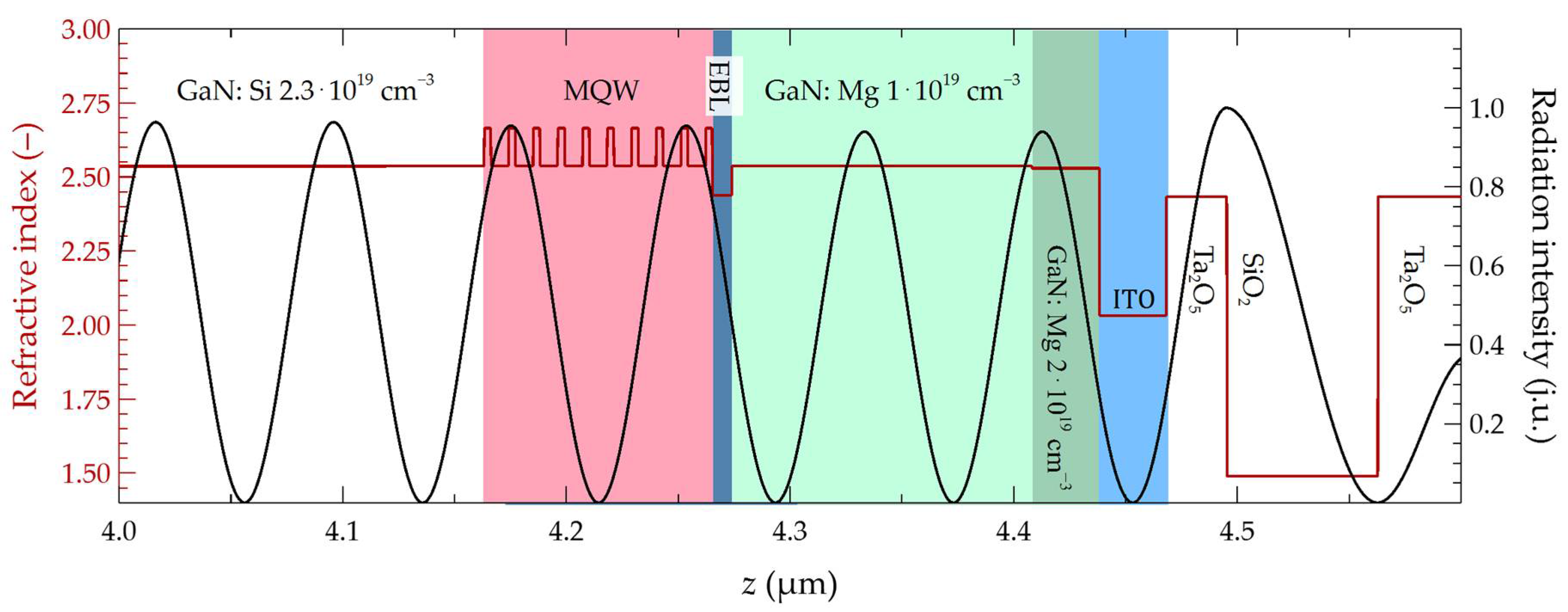
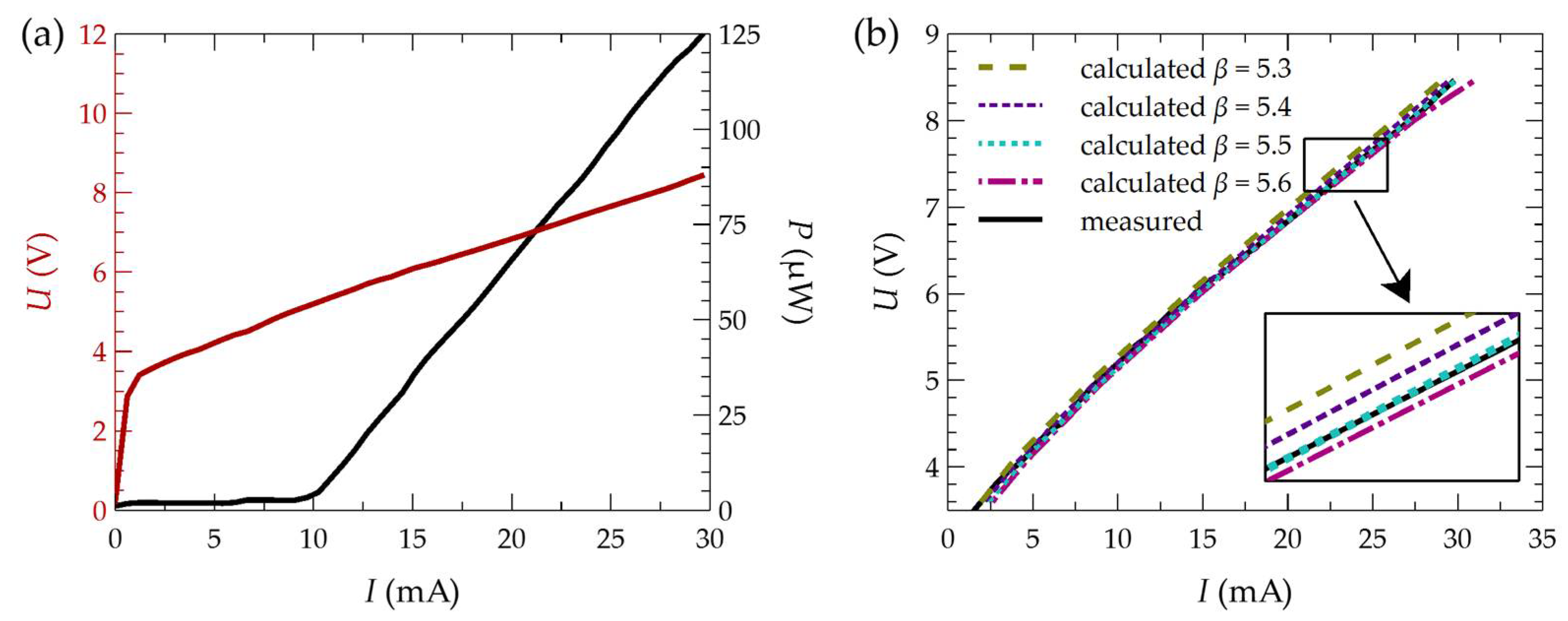

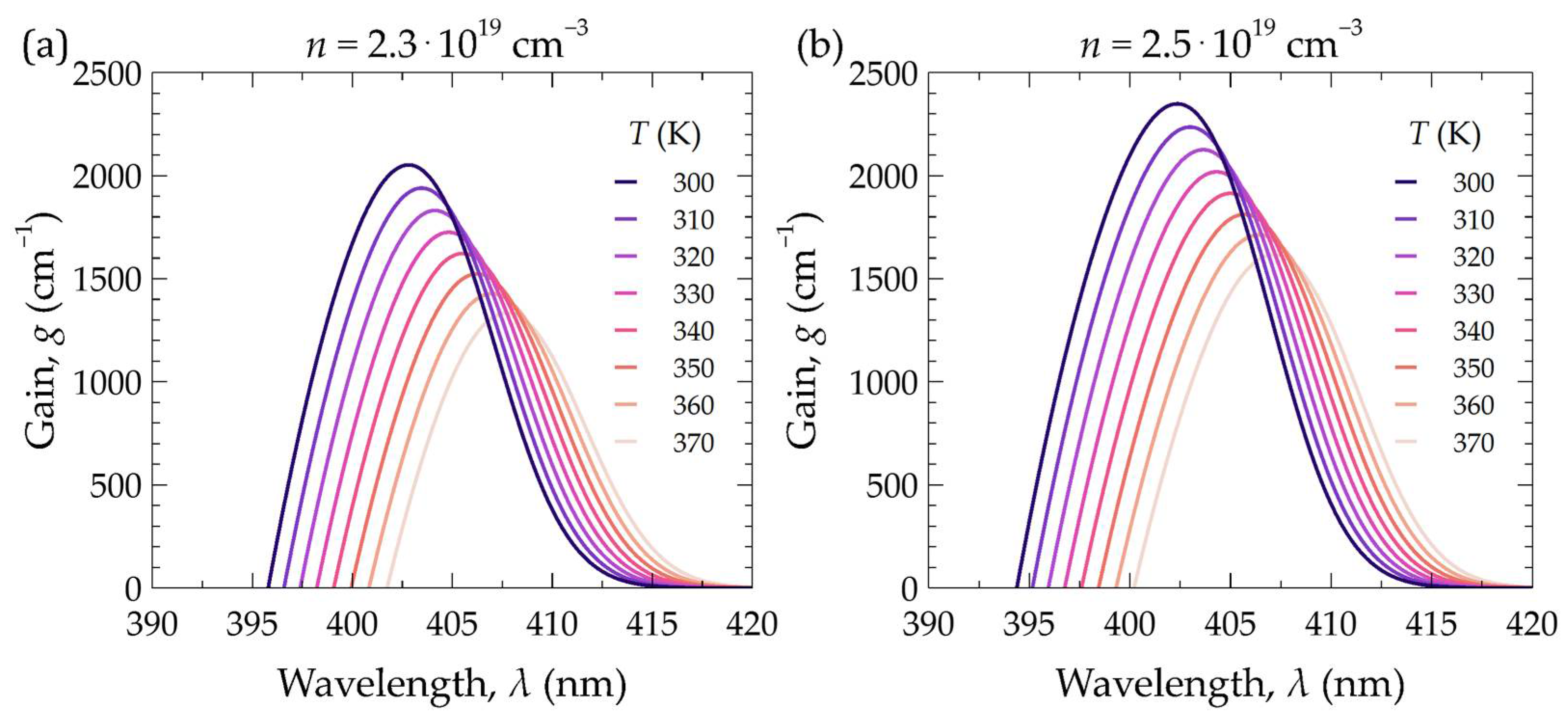
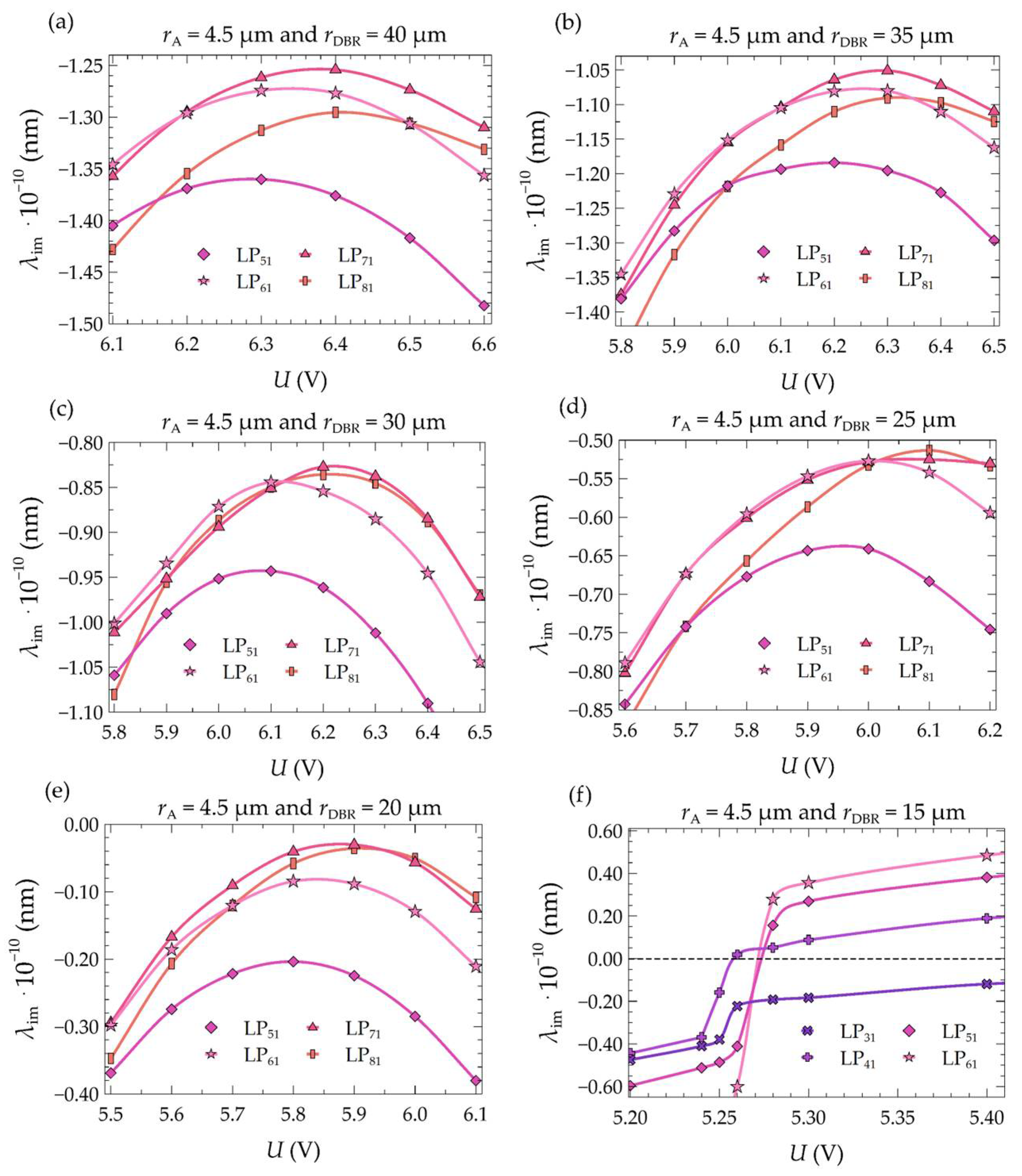
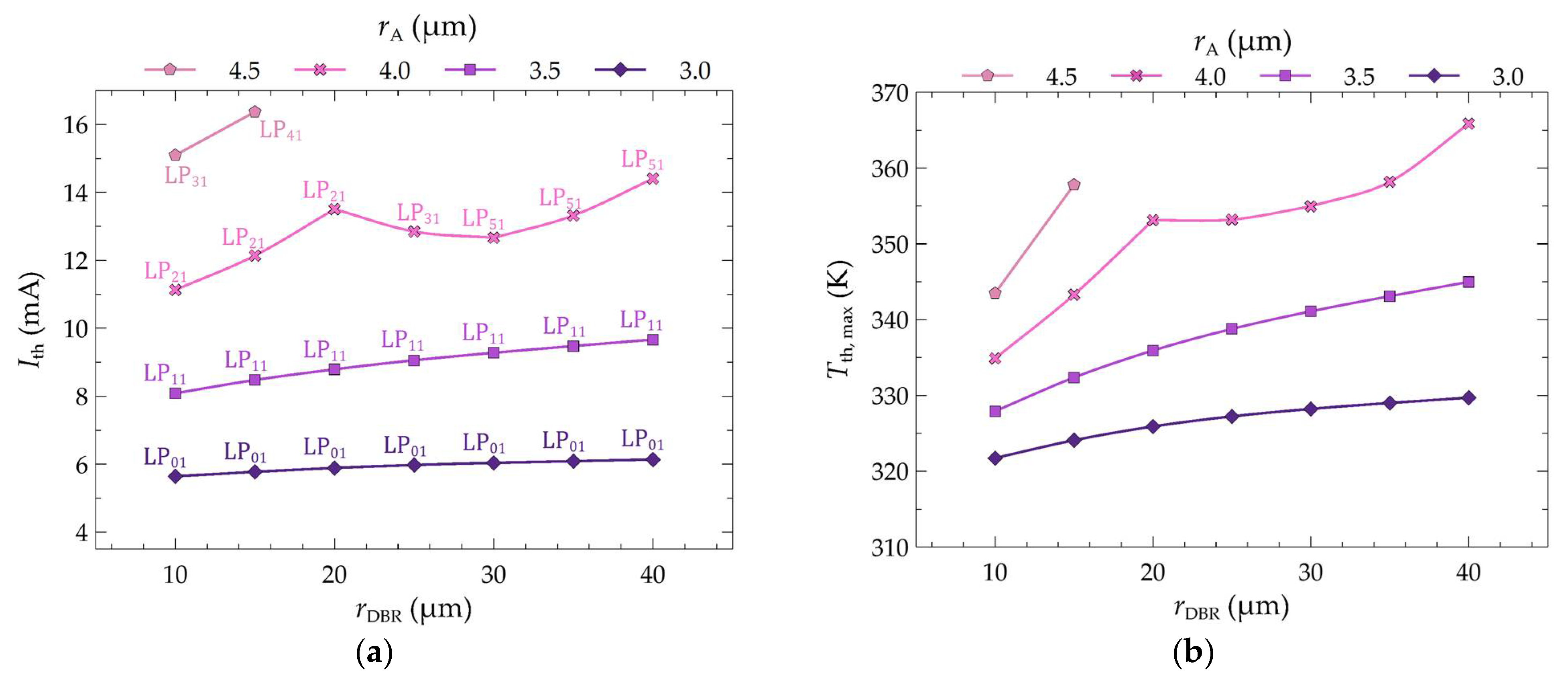
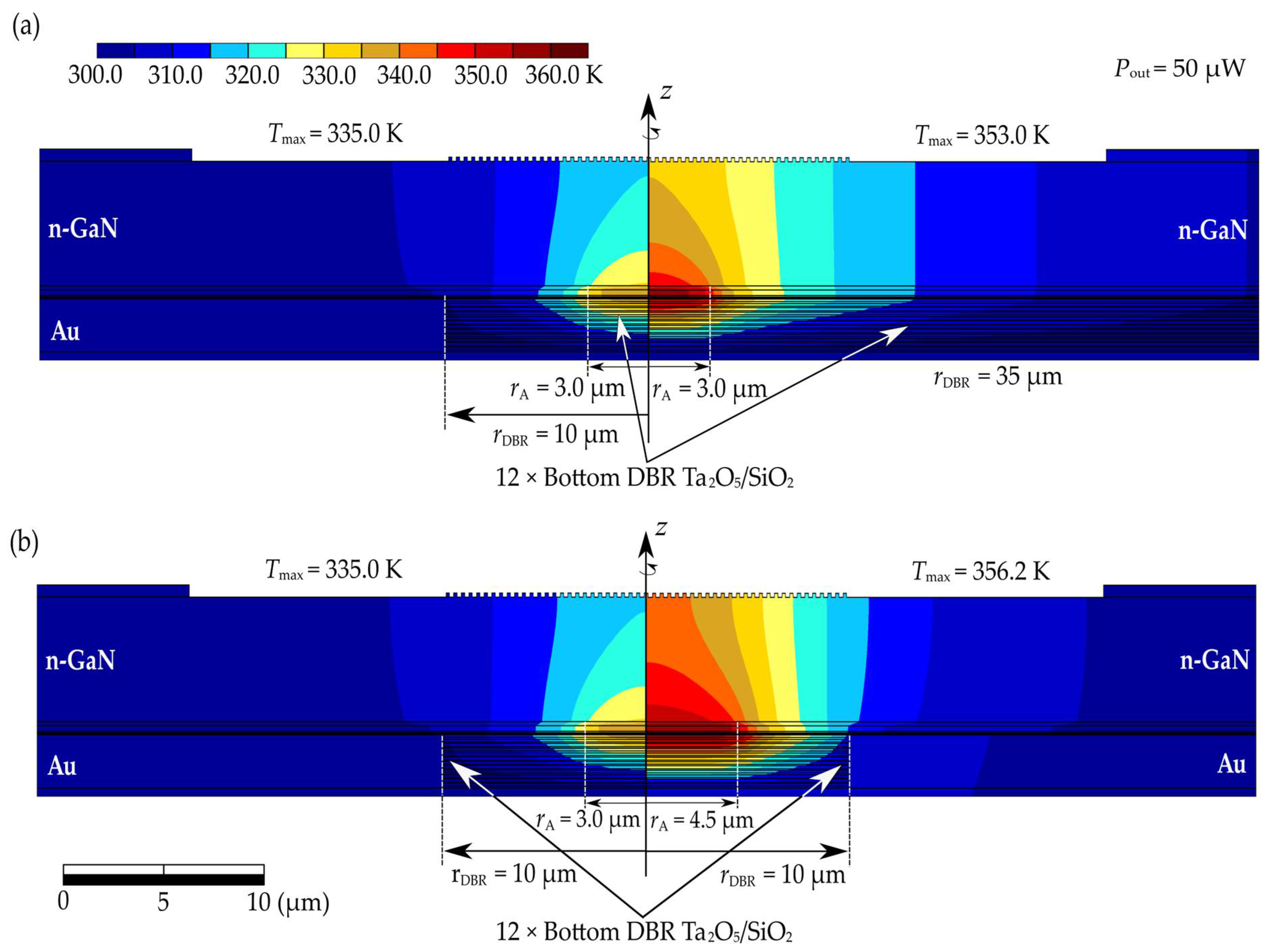
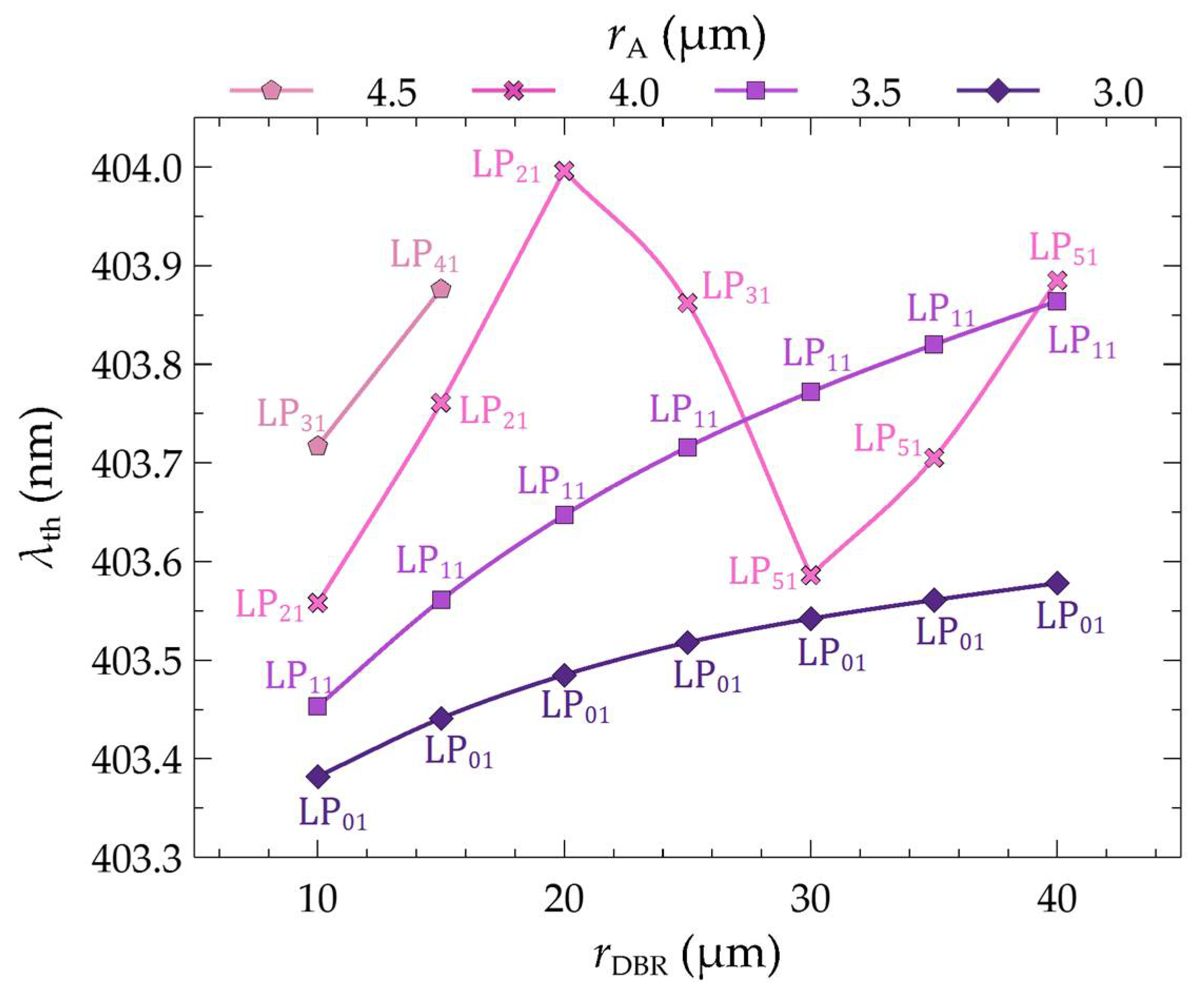
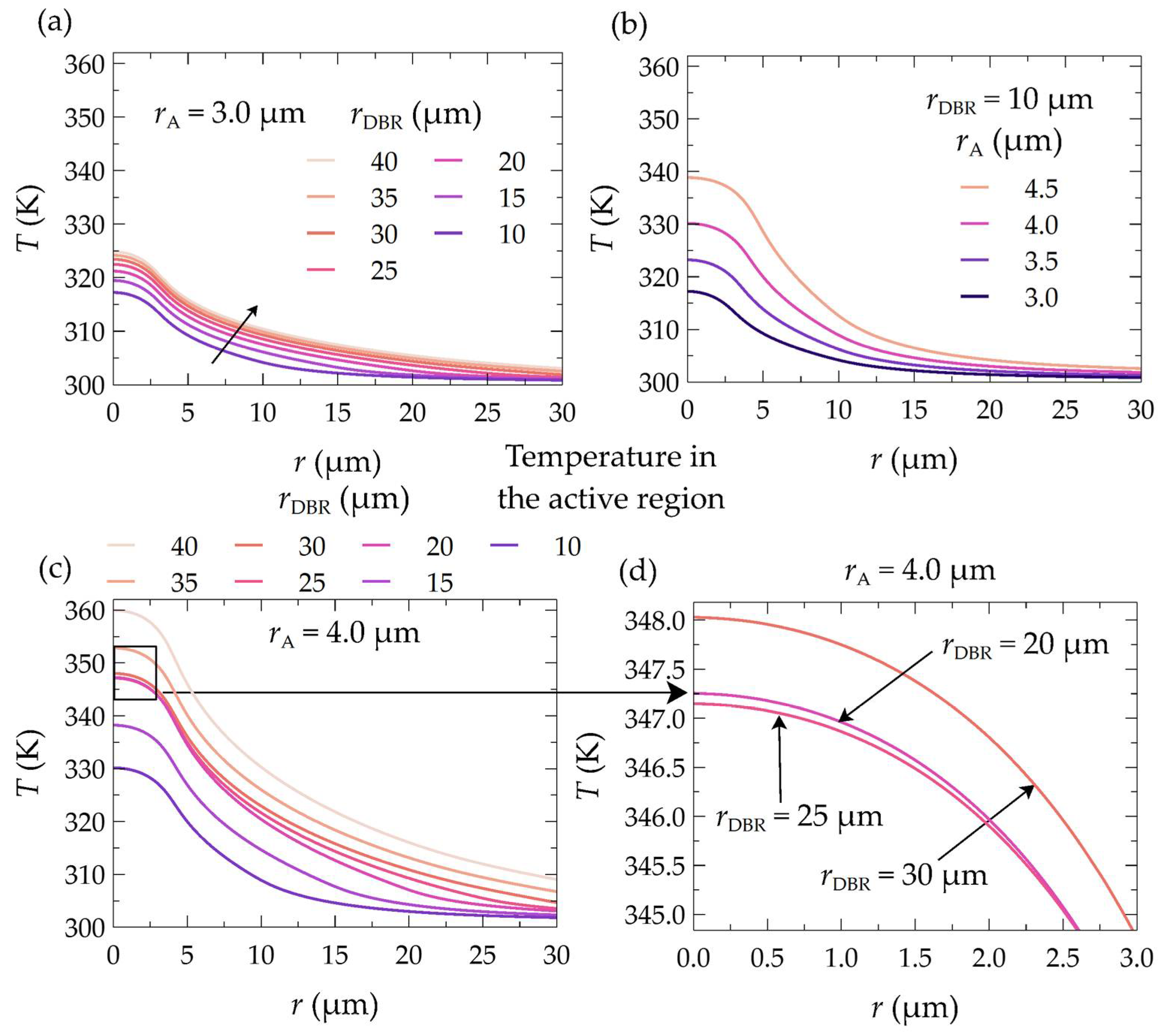
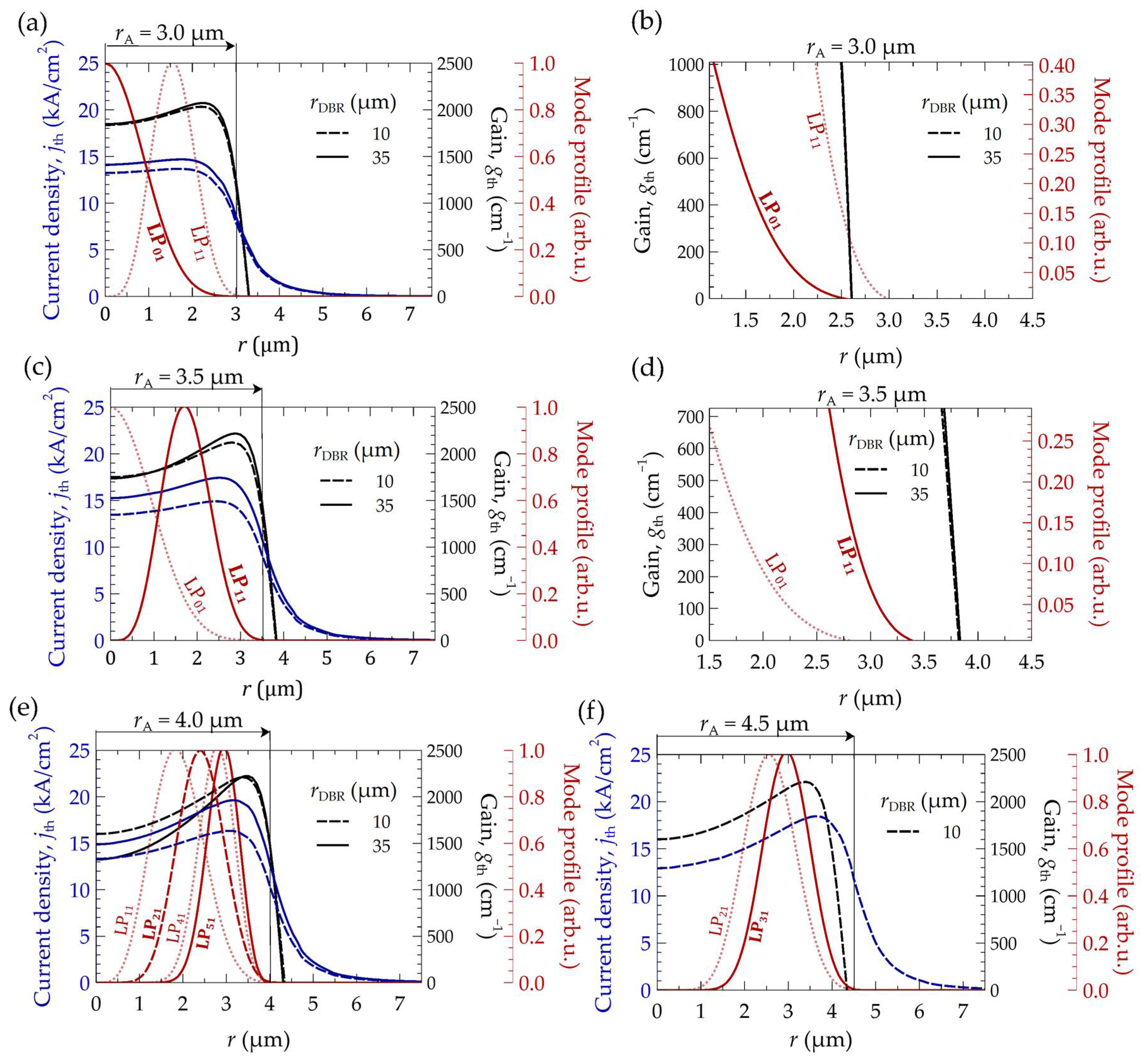
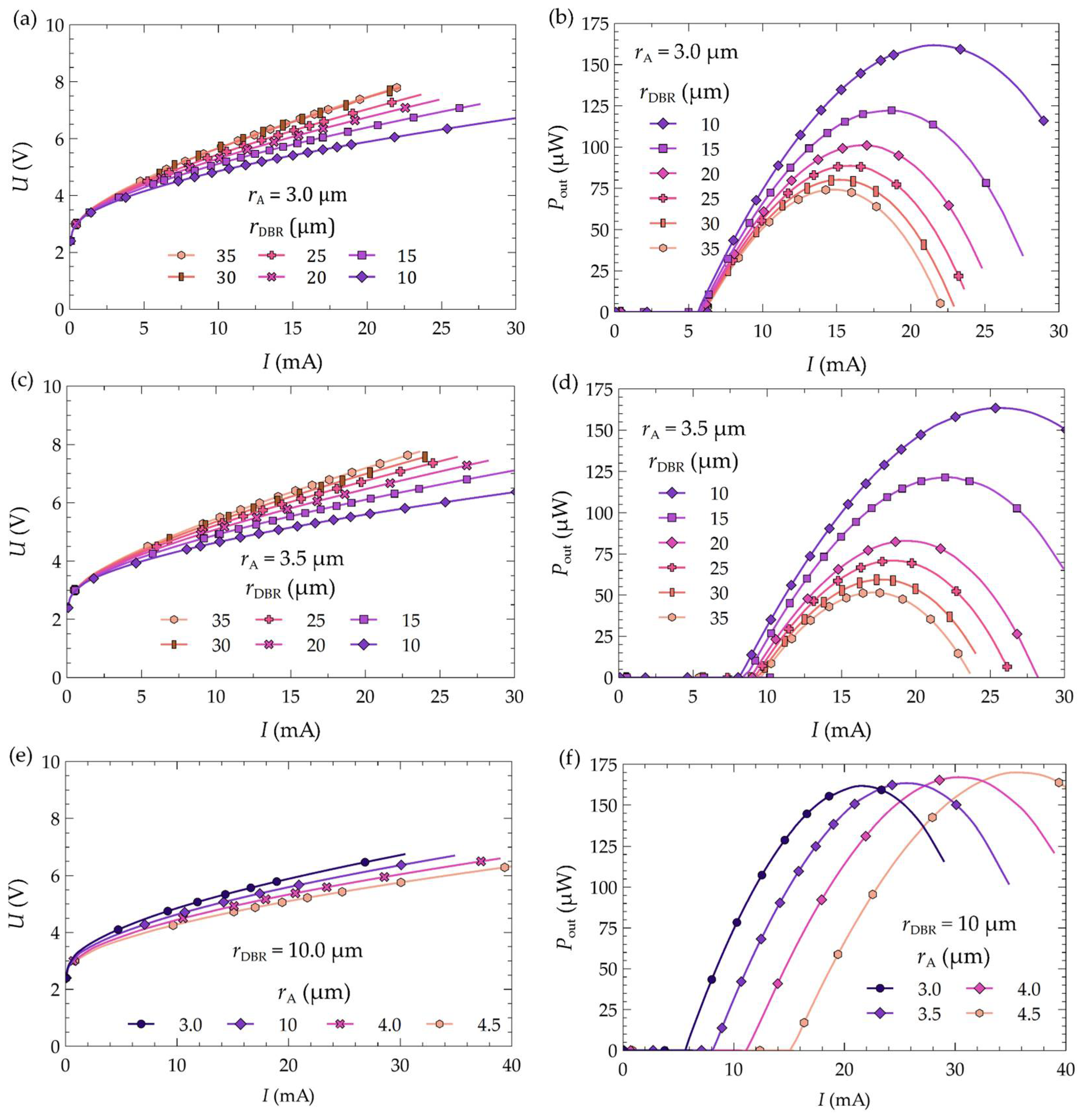
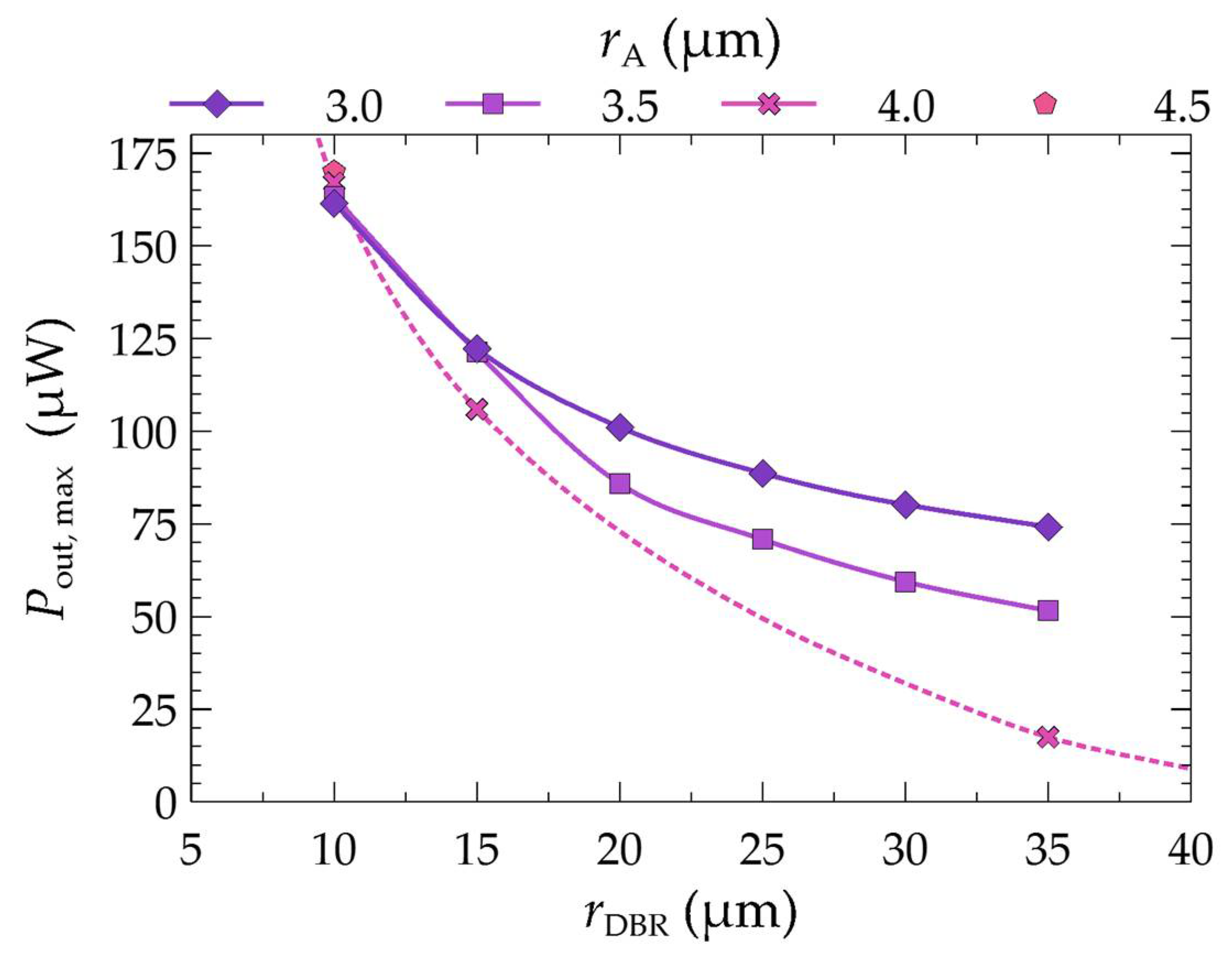
| Layer | Material | Thickness (μm) | Doping (cm−3) | k300K (W/(m·K)) | k400K (W/(m·K)) | σ300K (S/m) | σ400K (S/m) | ||
|---|---|---|---|---|---|---|---|---|---|
| Contact on the n-side | Au | 0.3 | – | 317.10 | 310.70 | 4.4 × 107 | 3.2 × 107 | ||
| Insulator | SiO2 | 0.3 | – | 1.38 | 1.38 | 1.0 × 10−6 | 1.0 × 10−6 | ||
| MHCG | u-GaN | 0.0988 | – | 72.19 | 48.26 | 5.2 × 104 | 4.9 × 104 | ||
| Spacer on the n-side | n-GaN | 3.0939 | Si: 2.3 × 1019 | 82.61 | 55.22 | 5.2 × 104 | 4.9 × 104 | ||
| Active region | 10 × QW | n-In0.1Ga0.9N | 0.003 | Si: 0.1 × 1019 | 7.15 | 4.78 | 263.26 | 249.69 | |
| 9 × B | GaN | 0.008 | undoped | 59.73 | 39.93 | 256.35 | 242.02 | ||
| EBL | p-Al0.2Ga0.8N | 0.0088 | Mg: 2.2 × 1019 | 14.65 | 19.38 | 18.54 | 75.79 | ||
| Spacer on the p-side | p-GaN | 0.1343 | Mg: 1.0 × 1019 | 83.35 | 55.72 | 71.27 | 243.76 | ||
| p-GaN | 0.03 | Mg: 2.0 × 1019 | 64.94 | 43.41 | 102.42 | 350.30 | |||
| Aperture | SiO2 | 0.03 | – | 1.38 | 1.38 | 1.0 × 10−6 | 1.0 × 10−6 | ||
| ITO | 0.030 | – | 3.20 | 3.20 | 1.0 × 106 | 1.0 × 106 | |||
| Phasing layer | Ta2O5 | 0.027 | – | 0.45 | 0.45 | 1.0 × 10−7 | 1.0 × 10−7 | ||
| Bottom DBR mirrors | 12× | Ta2O5 | 0.0414 | – | 0.45 | 0.45 | 1.0 × 10−7 | 1.0 × 10−7 | |
| SiO2 | 0.0676 | – | 1.38 | 1.38 | 1.0 × 10−6 | 1.0 × 10−6 | |||
| Contact on the p-side | Au | 5.0 | – | 317.10 | 317.10 | 4.4 × 107 | 3.2 × 107 | ||
| Carrier substrate | Si | 350.0 | – | 150.00 | 150.0 | 1.0 × 105 | 1.0 × 105 | ||
| Solder | PbSn | 10.0 | – | 50.00 | 50.50 | 6.7 × 106 | 6.7 × 106 | ||
| Heat sink | Cu | 5000 | – | 400.80 | 392.47 | 5.8 × 107 | 4.2 × 107 | ||
| Layer | Material | Doping (cm−3) | nr,300K (–) | nr,400K (–) | α300K (1/cm) | α400K (1/cm) | ||
|---|---|---|---|---|---|---|---|---|
| Contact on the n-side | Au | – | 5.3935 | 5.3935 | 1.8 × 106 | 1.8 × 106 | ||
| Insulator | SiO2 | – | 1.4893 | 1.4893 | 0.02 | 0.02 | ||
| MHCG | u-GaN | – | 2.5137 | 2.5314 | 18.61 | 23.38 | ||
| Spacer on the n-side | n-GaN | Si: 2.3 × 1019 | 2.5137 | 2.5314 | 18.61 | 23.38 | ||
| Active region | 10 × QW | n-In0.1Ga0.9N | Si: 0.1 × 1019 | 2.6574 | 2.6768 | Gain 1 | Gain 1 | |
| 9 × B | GaN | undoped | 2.5320 | 2.5497 | ||||
| EBL | p-Al0.2Ga0.8N | Mg: 2.2 × 1019 | 2.4332 | 2.4478 | 0.16685 | 0.2988 | ||
| Spacer on the p-side | p-GaN | Mg: 1.0 × 1019 | 2.5308 | 2.5485 | 6.208 | 11.237 | ||
| p-GaN | Mg: 2.0 × 1019 | 2.5295 | 2.5472 | 14.085 | 24.1258 | |||
| Aperture | SiO2 | – | 1.4893 | 1.4893 | 0.02 | 0.02 | ||
| ITO | – | 2.0311 | 2.0311 | 3257.81 | 3257.81 | |||
| Phasing layer | Ta2O5 | – | 2.4337 | 2.4337 | 97.635 | 97.635 | ||
| Bottom DBR mirrors | 12 × | Ta2O5 | – | 2.4337 | 2.4337 | 97.635 | 97.635 | |
| SiO2 | – | 1.4893 | 1.4893 | 0.02 | 0.02 | |||
| Contact on the p-side | Au | – | 5.3935 | 5.3935 | 1.8 × 106 | 1.8 × 106 | ||
| CW | Ith (mA) | |||
|---|---|---|---|---|
| 3.0 | 3.5 | 4.0 | 4.5 | |
| 10 | 5.64 | 8.09 | 11.13 | 15.09 |
| 15 | 5.77 | 8.48 | 12.14 | 16.37 |
| 20 | 5.89 | 8.79 | 13.51 | not working |
| 25 | 5.98 | 9.06 | 12.85 | not working |
| 30 | 6.04 | 9.28 | 12.66 | not working |
| 35 | 6.09 | 9.48 | 13.32 | not working |
| 40 | 6.14 | 9.67 | 14.40 | not working |
Disclaimer/Publisher’s Note: The statements, opinions and data contained in all publications are solely those of the individual author(s) and contributor(s) and not of MDPI and/or the editor(s). MDPI and/or the editor(s) disclaim responsibility for any injury to people or property resulting from any ideas, methods, instructions or products referred to in the content. |
© 2024 by the authors. Licensee MDPI, Basel, Switzerland. This article is an open access article distributed under the terms and conditions of the Creative Commons Attribution (CC BY) license (https://creativecommons.org/licenses/by/4.0/).
Share and Cite
Dąbrówka, D.; Sarzała, R.P. Study on Bottom Distributed Bragg Reflector Radius and Electric Aperture Radius on Performance Characteristics of GaN-Based Vertical-Cavity Surface-Emitting Laser. Materials 2024, 17, 3107. https://doi.org/10.3390/ma17133107
Dąbrówka D, Sarzała RP. Study on Bottom Distributed Bragg Reflector Radius and Electric Aperture Radius on Performance Characteristics of GaN-Based Vertical-Cavity Surface-Emitting Laser. Materials. 2024; 17(13):3107. https://doi.org/10.3390/ma17133107
Chicago/Turabian StyleDąbrówka, Dominika, and Robert P. Sarzała. 2024. "Study on Bottom Distributed Bragg Reflector Radius and Electric Aperture Radius on Performance Characteristics of GaN-Based Vertical-Cavity Surface-Emitting Laser" Materials 17, no. 13: 3107. https://doi.org/10.3390/ma17133107
APA StyleDąbrówka, D., & Sarzała, R. P. (2024). Study on Bottom Distributed Bragg Reflector Radius and Electric Aperture Radius on Performance Characteristics of GaN-Based Vertical-Cavity Surface-Emitting Laser. Materials, 17(13), 3107. https://doi.org/10.3390/ma17133107






